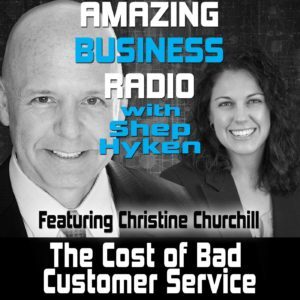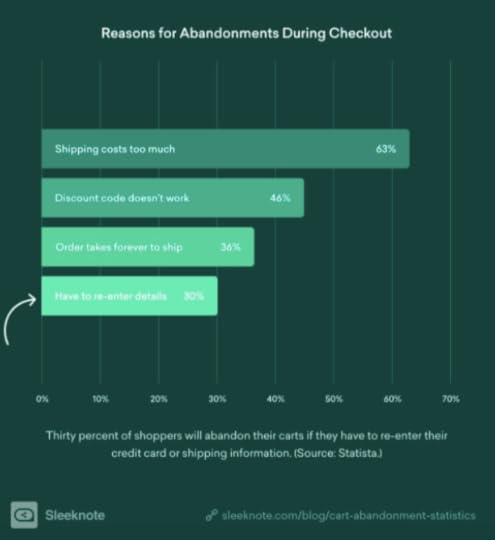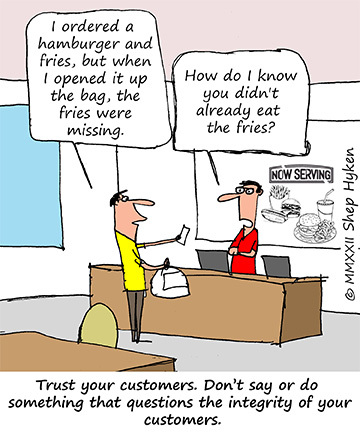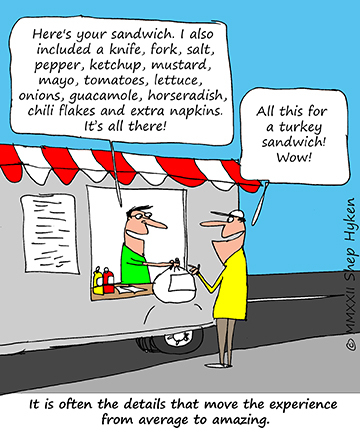Shep Hyken's Blog, page 62
June 21, 2022
Amazing Business Radio: Christine Churchill
 The Cost of Bad Customer Service
The Cost of Bad Customer ServiceThe Impact of Bad Customer Service on Your Customers, Employees, and ROI
Shep Hyken interviews Christine Churchill, Founder and CEO of the Customer Service Institute of America (CSIA). She shares how organizations can identify, measure, and address issues to improve customer experience.






 Top Takeaways:Customers are smarter than ever before. They don’t benchmark you against a direct competitor. They’re comparing you to the best service they’ve had from any company out there.When customers were asked to define great service, they described a company with people who can resolve problems, know their products, are easy to reach, and don’t waste their time.Investing in your employees’ training makes them feel good about themselves. Give them the tools so that when a customer is upset, angry, or yelling, they know exactly how to handle the situation.Your team members feel the pain points in your business process as much as your customers. Customer surveys are helpful, but asking your team members where these glitches are in the process is the first thing you should do.Christine also shares these stats and facts about the cost of bad customer service for an organization:89% of consumers have said that they will spend 17% more on a service if they feel that they will receive a better service experience.If you can increase your customer retention just by 5%, you can improve your bottom line revenue by 25% to 95%.A 1% increase in CSAT results in a 4.6% increase in overall market value.And Christine shares the formula businesses can use to calculate the cost of bad customer service. Tune in!Quotes:
Top Takeaways:Customers are smarter than ever before. They don’t benchmark you against a direct competitor. They’re comparing you to the best service they’ve had from any company out there.When customers were asked to define great service, they described a company with people who can resolve problems, know their products, are easy to reach, and don’t waste their time.Investing in your employees’ training makes them feel good about themselves. Give them the tools so that when a customer is upset, angry, or yelling, they know exactly how to handle the situation.Your team members feel the pain points in your business process as much as your customers. Customer surveys are helpful, but asking your team members where these glitches are in the process is the first thing you should do.Christine also shares these stats and facts about the cost of bad customer service for an organization:89% of consumers have said that they will spend 17% more on a service if they feel that they will receive a better service experience.If you can increase your customer retention just by 5%, you can improve your bottom line revenue by 25% to 95%.A 1% increase in CSAT results in a 4.6% increase in overall market value.And Christine shares the formula businesses can use to calculate the cost of bad customer service. Tune in!Quotes:“Everything is digital. Anybody can look up and see the service experiences other people, who are their peers, have had with your company before they buy.”
“It’s not just customers leaving your business that cost money. Bad service to your internal customers (your employees) also costs money.”
“Always ask your team for their ideas. Their ideas are free, and often they are the ones that are going to impact your business the most.”
About:Christine Churchill is a customer experience expert and the Founder and CEO of the Customer Service Institute of America. She has worked with organizations around the globe from a variety of industries, management styles, training approaches, systems, and technologies.
Shep Hyken is a customer service and experience expert, New York Times bestselling author, award-winning keynote speaker, and your host of Amazing Business Radio.
This episode of Amazing Business Radio with Shep Hyken answers the following questions and more:
What is the cost of bad service?How do you measure the cost of bad service?How can organizations identify the cause of bad customer service?Does customer service affect retention?What makes customer service great?The post Amazing Business Radio: Christine Churchill appeared first on Shep Hyken.
June 20, 2022
5 Top Customer Service Articles of the Week 6-20-2022
Each week I read many customer service and customer experience articles from various resources. Here are my top five picks from last week. I have added my comment about each article and would like to hear what you think too.
Eight Tips To Get Inactive Customers Excited About Your Business Again by Young Entrepreneur Council(Forbes) Without customer loyalty, a business can struggle to succeed. While your business may have a few standout customers who have become brand ambassadors for your product or service, the unengaged or inactive customers are often the ones you need feedback from the most. These customers can provide candid and honest feedback as to why they aren’t more engaged with your business.
My Comment: It’s not unreasonable to think that a customer that left you for a competitor might come back in the future – especially if you make an effort to do so. The Young Entrepreneur Council at Forbes shares eight ideas on exactly how to do that. While some of these are very common sense, it surprises me that more people/companies don’t use these tips.
How to Create a Total Experience that Fulfills 3 Fundamental Customer Needs by Kate Kompelien(CMSWire) For as long as goods have been bought and sold, customer expectations for how these goods should be delivered have been in a constant state of evolution. Consider the example of coffee. At first, coffee was cheap and plentiful — though options for consuming it were limited. Then came the pre-packaged goods economy, where consumers could purchase pre-roasted beans and product offerings diversified. As this economic model gave way to the service economy, customers began to seek out coffee brands with a signature style, which opened the door to new custom brews and flavors.
My Comment: This article features the three basic needs of (most) every customer. The first is a functional need. The product or service needs to do what it’s supposed to do. The second is an emotional need, which considers how someone feels when interacting with a company or brand. And the third is a social need. Many customers want the companies they do business with to give back at some level.
What You’re Getting Wrong About Customer Journeys by Ahir Gopaldas and Anton Siebert(Harvard Business Review) Most marketing experts agree that it’s not enough to give customers a satisfying initial experience with a product. Instead, product managers must offer them a compelling series of experiences—a customer journey—to keep them coming back for more. The design of customer journeys is the new marketing battleground.
My Comment: Anytime an article about customer service or CX comes out in the Harvard Business Review (HBR), I get excited to learn something new. The gist of this article is that it’s not enough to give customers an “initial satisfying experience with a product.” Instead, provide them with a series of experiences. In other words, give them a customer journey that makes them come back for more.
Let Your Brand Strategy Be Your Superpower by Julie Reeves(Gartner) The thing is, there’s no superhuman ability required to have all that for your organization — and more. All it takes — and I get that this is no small task — is a solid brand strategy. In a highly competitive and polarized environment, a strong brand strategy is not only valuable, it’s essential. Unfortunately, most companies find it difficult to stand out from the competition. According to a Gartner survey, only one in four respondents can see a difference between brands in a given competitive set.
My Comment: Brand strategy and CX strategy go hand in hand. Many companies/brands don’t focus enough attention on the brand strategy. Here are six reasons you should make this a priority. While you may not agree with all six, you’ll find something here that will make a great conversation starter at your next brand strategy meeting? (What, you don’t have brand strategy meetings? Maybe it’s time to start!)
Consumers Embracing Premium Loyalty Programs by Retail Customer Experience(Retail Customer Experience) Consumers are more likely than ever to join a premium loyalty program and willing to pay if the program guarantees discounts and offers relevant benefits.
My Comment: This short article includes a number of findings from the Clarus Commerce 2022 Premium Loyalty Data Study. If you have a loyalty program, you’ll want to read these stats. A significant finding was that 72% of the 2,500 U.S. consumers were already enrolled in a premium loyalty program, and 77% who weren’t said they would join one if a favorite brand offered it.
[image error]Shep Hyken is a customer service expert, professional speaker, and New York Times bestselling business author. Go to The Customer Focus to learn more about our customer service training programs. Follow on Twitter: @Hyken
to learn more about our customer service training programs. Follow on Twitter: @Hyken
The post 5 Top Customer Service Articles of the Week 6-20-2022 appeared first on Shep Hyken.
June 17, 2022
Guest Post: 5 Consumer Trends Small Business Owners Should Be Aware Of
This week we feature an article by Devin Pickell, Growth Marketing Manager at Privy. He shares the five consumer trends organizations can use in their next campaigns and strategy.
It’s difficult to stay on top of everything as a small business owner, especially in today’s fast-paced environment. So getting a competitive edge on what your consumers prefer can be extremely beneficial for your business.
After careful research and talking with other brands, we put together five consumer trends that will take shape over the next few years. Use this information to inform future strategies and campaigns your business will be running.
More consumers want text messages from brandsDid you know that 8 out of 10 consumers say they’re enrolled in at least one text message marketing program? Or that 63% of online shoppers have made at least one purchase within the last 90 days from a text marketing campaign?
SMS marketing has been one of the fastest-growing sales channels in the past few years as consumers become more comfortable with exchanging their phone numbers for exclusive offers and promotions from online retailers.
We know that online shopping increasingly occurs through mobile devices, so it makes sense that consumers want offers sent directly to their fingertips. Consumers are also on their smartphones now more than ever. Finally, email marketing fatigue and clogged inboxes has contributed to the rise of SMS marketing.
Being able to text with customers allows for a direct line of communication and allows your brand to build one-on-one relationships with subscribers. Your messages will cut through crowded inboxes and make your offers seem more personalized, timely, and intimately attention-grabbing.
Takeaway: Consider using SMS in your small business if you aren’t already, as there are tons of affordable options out there right now while it’s early. But don’t get rid of email altogether. We find that pairing your SMS and email marketing offers together allows for the best results. Either way, your customers will appreciate the option to opt-in for their preferred marketing channel.
Consumers are taking their online security more seriously than everUnfortunately, with technological innovation comes more ways to target consumers for scams. According to data from TechRepublic, people are becoming increasingly concerned about what happens when they share their contact and/or financial information with online merchants:
86% of people surveyed reported growing fears about their online personal security. 78% admitted that they’re concerned about what data companies collect on them. 40% say they don’t trust that companies are actually keeping their data safe.So what does this mean for your small business? That you need to build trust with new and existing customers so they know their sensitive information is safeguarded.
Provide safe and secure browsing and checkout process in your online store, no matter what device your customers use to shop. Display trust badges throughout your website to give them confidence in your protective measures, and make sure your site is up-to-date with the latest security features. And if customers require extra measures, they should look for a dark web scanner to get a full security analysis.
Takeaway: Prioritize your online security or risk losing customers/hurting customer trust.
Consumers want easy access to supportWhen customers reach out to your business, they want to be acknowledged and feel seen, regardless if they reached out via social media, phone, or email. Adding friction to your support process is one of the quickest ways to hurt your reputation with customers, even longtime customers.
Ignoring your social DMs or leaving customer support emails for a few days may lead to negative comments on social media and review platforms. As a small business, these negative comments and reviews can have a big impact.
While providing “always on” support is easier said than done, there are a few ways to make things easier on yourself and make your customers happier:
Automate post-purchase and order confirmation emails so that your customers are in the loop every step of the way. Master one or two support channels before overwhelming your team with tickets from multiple sources. Make your support channels easy to find on your website and be as responsive as possible when tickets come through.Takeaway: Be more available to your customers and online shoppers, and don’t shy away from candid conversations with customers. They’ll appreciate your personalized responses more than you know. This level of support and personalization is what will set your small business apart from other brands.
Make ‘try before you buy’ simpleWhether it’s a free online trial or a free product sample, ‘free’ has always been one of the best ways to let customers test the waters with your business. They can see what your products are really like before committing to buying the full experience.
Samples are especially vital for online businesses. Because shoppers can’t physically engage with your products in person, worries about how your items may appear, smell, feel, etc., may prevent them from making a purchase if the product description isn’t up to par.
Takeaway: Find creative ways to give shoppers a free taste of your brand, and have some fun with it.
Run free product giveaways on your social media channels occasionally. Offer to send potential customers a freebie in exchange for their phone number or email address on your website. Send your existing customers samples of products they haven’t tried yet with each order — and a discount code to buy the full-size version next time.You could also provide a money-back guarantee or a free trial to help ease shoppers’ minds. This risk-free offer shows they have nothing to worry about and subtly encourages sales. People will make purchases they may have been on the fence about if you use trust-building strategies like these.
Free and fast shipping is the standardA whopping 8 in 10 customers admit that free shipping makes them more likely to purchase from brands. While it’s not feasible to compete with big-box retailers, you’ll need to at least offer a threshold for customers to receive free shipping.
Forcing customers to pay the cost of shipping may lead to an increase in cart abandonment rates. In fact, Sleeknote charted the most common reasons people leave their carts, and shipping costs were the top reason:

Takeaway: Small businesses must figure out how to offer free, fast shipping without losing money. Crunch the numbers and make this incentive possible during your checkout stage, or risk losing business.
If your small business is looking to sell without carrying tons of inventory, you can consider adding drop shipping as a way to relieve some of the stress of shipping. It could also help cut costs.
Now you knowNow you have a competitive edge on what consumers are looking for. Use this article as your roadmap for what to tackle first. Go through each takeaway and craft a winning game plan that makes the most sense for your small business
Devin Pickell is a Growth Marketer at Privy. He combines his skills in content marketing, SEO, data analysis, and marketing strategy to meet customers at the right moment in their journey.
 For more articles from Shep Hyken and his guest contributors go to customerserviceblog.com.
For more articles from Shep Hyken and his guest contributors go to customerserviceblog.com.
Read Shep’s latest Forbes article: Selling To Gen-Z: This Is What They Want
The post Guest Post: 5 Consumer Trends Small Business Owners Should Be Aware Of appeared first on Shep Hyken.
June 15, 2022
Another Lesson on How to Handle Angry Customers: Don’t Smell the Milk
 At a recent conference, I enjoyed an interview with a business owner who shared some of his customer service philosophies. His name is Jake, and he is a very smart guy. He taught several lessons that day, but the one that stood out was how he handles angry customers. Specifically, it was a lesson he called Don’t Smell the Milk.
At a recent conference, I enjoyed an interview with a business owner who shared some of his customer service philosophies. His name is Jake, and he is a very smart guy. He taught several lessons that day, but the one that stood out was how he handles angry customers. Specifically, it was a lesson he called Don’t Smell the Milk.
Early in Jake’s career, he worked at a grocery store. His manager taught him how to respond to a disgruntled customer. The example he used had to do with a customer who wanted to return a spoiled carton of milk.
If a customer claims to have a carton of spoiled milk, the natural reaction would be for an employee to open the carton and “take a whiff of the milk.” As natural as that seems to be, your actions may send the message that you don’t trust your customer. You had to check to make sure the customer was telling the truth. Instead, Jake’s manager suggested taking the milk from the customer, no questions asked, and exchanging it for another carton. If you want to smell the milk, do it later.
That made me think of an experience I had at a restaurant. I had been there many times before and was excited to order my favorite entrée. The meal arrived, and I took my first bite. The sauce didn’t taste right. The manager happened to stop by to see how we were enjoying our meal. I mentioned that the sauce had a funny taste, and – I promise I’m not making this up – he dipped his finger into the sauce on my plate, put it in his mouth to taste it, thought for a moment, and said, “There’s nothing wrong with the sauce.”
Maybe there wasn’t anything “wrong” with the sauce, but to me, there was. Regardless, I’m a regular customer who had made just one negative comment after many visits, and this is how the manager handled it. Just like the spoiled milk example, the manager doubted my word. Furthermore, he chose to disagree with me. If you’ve been following my work, you know I don’t believe the customer is always right, but they are always the customer. This guy was interested in winning a debate about the sauce versus taking care of me. All he had to do was say something like, “I’m sorry. Is there something else I can get you?”
Instead, I was stuck with food that didn’t taste good to begin with and now tasted like the manager’s dirty finger. Okay, that’s a slight exaggeration, but who wants to eat food after witnessing an employee sticking his finger in it?
The lesson is clear. Trust your customers. Don’t say things or take actions that question the integrity of your customers. If you want your customers to trust you, you must also trust your customers.
Shep Hyken is a customer service expert, keynote speaker, and New York Times, bestselling business author. For information on The Customer Focus customer service training programs, go to www.thecustomerfocus.com. Follow on Twitter: @Hyken
customer service training programs, go to www.thecustomerfocus.com. Follow on Twitter: @Hyken
The post Another Lesson on How to Handle Angry Customers: Don’t Smell the Milk appeared first on Shep Hyken.
June 14, 2022
Amazing Business Radio: Jonathan Shroyer
 Building the Future of Service for the Next Generation of Customers
Building the Future of Service for the Next Generation of CustomersTrends That Will Affect Customer Service and Customer Experience
Shep Hyken interviews Jonathan Shroyer, Chief Customer Experience Innovation Officer of Arise Virtual Solutions, a customer service outsourcing and consulting firm. He shares insights about the future of customer service and the power of customer experience in driving tremendous value for your business.






 Top Takeaways:To get the C-suite to invest in customer experience, demonstrate ROI. You must understand what indicators drive business growth and compare it to the data that the customers provide based on their experience. Find a correlation between these sets of data and how it affects your revenue.When you lose a customer because of a negative experience, the new customers you gain will only make up for those who have left. It does nothing to increase your revenue. In comparison, if you take care of those customers the right way, they will stay, creating decade-long customers that will continuously bring in more business. And along the way, new customers will help continue to grow the business, as well.Shroyer shares the top 3 customer service and experience trends that he can see happening in the next decade.Trend #1 People are changing the way they work. In the old days, companies were at the wheel when it came to work-life harmony. Today, workers are moving towards a more flexible framework because they now have a choice of how they want to work. Employees are now empowered to choose where they want to work and where they want to live. We will be seeing a mega trend where companies will become more competitive with compensation, benefits packages, and remote work options to retain their customer service employees.Trend #2 Hybrid AI. When it comes to solving customer service problems in the future, it’s not a choice between bots or humans that will solve the customer’s problems. It will take both. A hybrid approach is where a skilled human being can come in, modify or improve upon what a bot has already done.Trend #3 AI One-on-One Companions. In the next five years, multiple companies will launch products where AI can solve 99% of known issues for a customer and only 1% where the customer needs to call a human customer service agent. This takes the concept of products like Alexa and Siri to a different level where AI one-on-one companions are fully customized and integrated with the customer’s passions and interests.Quotes:
Top Takeaways:To get the C-suite to invest in customer experience, demonstrate ROI. You must understand what indicators drive business growth and compare it to the data that the customers provide based on their experience. Find a correlation between these sets of data and how it affects your revenue.When you lose a customer because of a negative experience, the new customers you gain will only make up for those who have left. It does nothing to increase your revenue. In comparison, if you take care of those customers the right way, they will stay, creating decade-long customers that will continuously bring in more business. And along the way, new customers will help continue to grow the business, as well.Shroyer shares the top 3 customer service and experience trends that he can see happening in the next decade.Trend #1 People are changing the way they work. In the old days, companies were at the wheel when it came to work-life harmony. Today, workers are moving towards a more flexible framework because they now have a choice of how they want to work. Employees are now empowered to choose where they want to work and where they want to live. We will be seeing a mega trend where companies will become more competitive with compensation, benefits packages, and remote work options to retain their customer service employees.Trend #2 Hybrid AI. When it comes to solving customer service problems in the future, it’s not a choice between bots or humans that will solve the customer’s problems. It will take both. A hybrid approach is where a skilled human being can come in, modify or improve upon what a bot has already done.Trend #3 AI One-on-One Companions. In the next five years, multiple companies will launch products where AI can solve 99% of known issues for a customer and only 1% where the customer needs to call a human customer service agent. This takes the concept of products like Alexa and Siri to a different level where AI one-on-one companions are fully customized and integrated with the customer’s passions and interests.Quotes:“Customer service and experience are how organizations can protect their revenue.”
“Always be learning. Nobody has a silver bullet, but we all have amazing experiences. We can learn, listen, support, and collaborate with each other.”
About:Jonathan Shroyer is the Chief Customer Experience Innovation Officer of Arise Virtual Solutions, a customer service outsourcing and offshoring consulting firm. Recognized as a renowned thought leader in the industry through multiple mentions, Jonathan is a sought-after speaker and writer.
Shep Hyken is a customer service and experience expert, New York Times bestselling author, award-winning keynote speaker, and your host of Amazing Business Radio.
This episode of Amazing Business Radio with Shep Hyken answers the following questions and more:
What is the future of customer experience?What is a hybrid AI?How will the new work setups affect customer service?How does an AI One-on-One Companion work?How do you get the C-suite to invest in customer service and experience?The post Amazing Business Radio: Jonathan Shroyer appeared first on Shep Hyken.
June 13, 2022
5 Top Customer Service Articles of the Week 6-13-2022
Each week I read many customer service and customer experience articles from various resources. Here are my top five picks from last week. I have added my comment about each article and would like to hear what you think too.
Sign Me Up! 10 Tips for Success with Subscription Business Models by Amanda Davis(CustomerThink) Some of us are old enough to remember when subscriptions were limited to just sports clubs, newspapers, and magazines. In fact, the subscription-based business model has been around since the 1770s. It was originally established in London as a way to expand newspaper sales. In 2009 only 18% of the value of the top 100 brands was in subscriptions. This grew to 29% by 2018.
My Comment: We kick off this week’s Top Five with an article about the subscription model. If you say the word “subscription,” most people think of magazines and newspapers. Not anymore! Just about any business can offer a subscription. You can even subscribe to a car! This article shares excellent examples of different subscription models and success strategies.
Why AI Customer Journeys Need More Friction by Renée Richardson Gosline(Harvard Business Review) Friction isn’t always a bad thing, especially when companies are looking for responsible ways to use AI. The trick is learning to differentiate good friction from bad, and to understand when and where adding good friction to your customer journey can give customers the agency and autonomy to improve choice, rather than automating the humans out of decision-making.
My Comment: I was immediately drawn to this article because of the title. Why would you want to put more friction into a customer journey? The answer has to do with AI (Artificial Intelligence). The short version is that too much AI is not a good thing. Do not “automate the humans out of decision-making.” Is there really such a thing as good friction? This article has the answer.
Customer Experience Is Getting Worse by Katie Deighton(The Wall Street Journal) The quality of customer experience offered by consumer-facing brands and government agencies declined in the year through April 2022. That’s according to Forrester Research Inc.’s latest annual study on customer experience, which analyzed 96,211 U.S. consumers’ perceptions of 221 companies and federal agencies. Forrester derived customer experience scores of 0 to 100 from respondents’ answers to questions such as how easy a brand is to work with and how likely they are to use a brand again.
My Comment: Here’s another title that grabbed my attention. I can confirm, based on the numbers, customer experience (CX) is getting worse. Between supply chain problems and employee issues, it is difficult for many companies to provide the same level of service they have in the past. While this article doesn’t have the answers, the points throughout can make for great conversation starters in your next leadership meeting.
Tools to Manage Customer Unhappiness by Servicebrand Global(Servicebrand Global) Is it admirable to pursue a business model or strategic plan that aims to ensure all your customers are happy all the time? Or is this approach unrealistic, leaving your organization open to criticism and self-doubt when faced with genuine customer dissatisfaction and unhappiness?
My Comment: It’s back to basics, as this article shares what to do when your customers aren’t happy or have a complaint. Here you’ll find some of the ingredients that can turn around that unhappy customer. Again, these are the basics; listen, show empathy, apologize, and more.
4 Things Customers Want in 2023 by Salesforce(Salesforce) “What do my customers want?” It’s one of the biggest, most important questions for success in business…and it changes all the time! Not to worry though. Tech influencer, Brian Tong has you covered. Watch to learn the four key takeaways from Salesforce’s State of the Connected Customer research report.
My Comment: We close out with something a little different. It’s not an article, but a short video from our friends at Salesforce sharing the four things customers want in 2023. This summarizes four findings from the State of the Connected Customer study. Tech Influencer, Brian Tong is your host and brings great energy and enthusiasm to this important topic.
[image error]Shep Hyken is a customer service expert, professional speaker, and New York Times bestselling business author. Go to The Customer Focus to learn more about our customer service training programs. Follow on Twitter: @Hyken
to learn more about our customer service training programs. Follow on Twitter: @Hyken
The post 5 Top Customer Service Articles of the Week 6-13-2022 appeared first on Shep Hyken.
June 8, 2022
A Lesson from Michelangelo: Details Matter
 I don’t know if it’s true, but it doesn’t matter. This is a great story with a great lesson.
I don’t know if it’s true, but it doesn’t matter. This is a great story with a great lesson.
Michelangelo was standing on his scaffold as he worked on painting a tiny leaf on the ceiling of the Sistine Chapel. A colleague looked up from far below and shouted, “Why are you so concerned about painting that little leaf? Nobody from this distance will ever know.”
Michelangelo responded, “I will know!”
The point is that the smallest details matter. Even if they don’t matter to the customer, they should still matter to you. It’s a sense of pride, dedication, and discipline that you care enough not to cut corners, take shortcuts or gloss over details.
If he were living today, Michelangelo would be the guy you want doing the maintenance check on your airplane before a flight, working on your car, or looking over the budget for your next big project. That’s when details really matter, and a person who obsesses over details is one you want on the team.
However, there are times when details might not be as important. Maybe you’re brainstorming a new product or coming up with a new strategy. It could be about anything. In a brainstorming process, you don’t worry about the details. You look at the big picture. Then, once you have an idea you think might work, you take the time to drill down and get into the details.
As it applies to customer experience (including customer service), it is often the little details that move the experience from average to amazing. I’ve always preached that the best companies don’t need to go over the top to be seen as amazing. They need to be just a little better than average. That’s often where the details come in.
For example, using a customer’s name at the right time is a small detail that adds to an experience. The garnish on a plate makes the entrée look better. Keeping the salt and pepper shakers full at a restaurant is never noticed until they aren’t full. The follow-up call you weren’t expecting pleasantly surprises you. It’s the same with a fast reply to an email or quick return phone call. None of these are big. It’s usually just “little things” – details that often are almost unnoticed – that give our customers confidence and help create customer amazement.
In the story, Michelangelo was saying that details, even if they aren’t obvious, are important to him. They are also important to our customers, whether they know it or not. Furthermore, Michelangelo could go home at night and sleep, knowing he did his best. We should strive for the same.
Shep Hyken is a customer service expert, keynote speaker, and New York Times, bestselling business author. For information on The Customer Focus customer service training programs, go to www.thecustomerfocus.com. Follow on Twitter: @Hyken
customer service training programs, go to www.thecustomerfocus.com. Follow on Twitter: @Hyken
The post A Lesson from Michelangelo: Details Matter appeared first on Shep Hyken.
June 7, 2022
Amazing Business Radio: Ian Johnston
 The Smart Shopper and the Value Gap
The Smart Shopper and the Value GapHow to Design Experiences that Exceed Your Customer’s Expectations
Shep Hyken interviews Ian Johnston, Founder of Quinine, a leading strategic retail design consultancy devoted to the power of design that drives innovation and growth. He talks about building trust and loyalty by designing meaningful customer engagement.






 Top Takeaways:A smart shopper is more than a way to describe a segment of your customers. Every customer seeks value whether they are buying luxury goods or everyday items. Smart shoppers take their past experiences and compare them to the experiences they have with you.The Value Gap is when a customer feels that they are getting more than they paid for. When they get more benefits than the price, this is when customer satisfaction is highest.Value is constantly changing. Each customer segment looks at different aspects of value differently. They may value price, quantity, brand virtues, sustainability, or the look and feel of a store. You have to move with your customers as their expectations of value change. To exceed their expectations, you have to meet them first.Customer service, virtues, and values will differentiate your brand. In retail, you can use your store to bring your company’s virtues and values to life by promoting and reinforcing the value proposition in your marketing campaigns.The customer’s baseline expectations are shaped by society. If you don’t meet the expectations of the customer and that of the community, you will get left behind.Quotes:
Top Takeaways:A smart shopper is more than a way to describe a segment of your customers. Every customer seeks value whether they are buying luxury goods or everyday items. Smart shoppers take their past experiences and compare them to the experiences they have with you.The Value Gap is when a customer feels that they are getting more than they paid for. When they get more benefits than the price, this is when customer satisfaction is highest.Value is constantly changing. Each customer segment looks at different aspects of value differently. They may value price, quantity, brand virtues, sustainability, or the look and feel of a store. You have to move with your customers as their expectations of value change. To exceed their expectations, you have to meet them first.Customer service, virtues, and values will differentiate your brand. In retail, you can use your store to bring your company’s virtues and values to life by promoting and reinforcing the value proposition in your marketing campaigns.The customer’s baseline expectations are shaped by society. If you don’t meet the expectations of the customer and that of the community, you will get left behind.Quotes:“Our expectations aren’t necessarily set by our competitors. They are set by everything that happens in the world.”
“There are certain aspects of value that aren’t tied to price and quality. Virtues and how a company treats its staff are aspects of value that are gaining more importance for customers.”
“Look at your customer journey and find opportunities to add value so you can, not just meet, but exceed your customer’s expectations.”
“The moment of delight happens when you create the value gap, and your customers walk away from the experience thinking that they got more than what they paid for.”
About:Ian Johnston is the Founder of Quinine, a leading strategic retail design consultancy devoted to the power of design to drive innovation and growth. The consultancy helps brands create world-class social, cultural, and commercial experiences that enrich and delight their customers’ everyday lives.
Shep Hyken is a customer service and experience expert, New York Times bestselling author, award-winning keynote speaker, and your host of Amazing Business Radio.
This episode of Amazing Business Radio with Shep Hyken answers the following questions … and more:
What is the Value Gap?What is a Smart Shopper?How can you understand customer expectations?How do you create meaningful customer engagement?What do customers value most in a business?The post Amazing Business Radio: Ian Johnston appeared first on Shep Hyken.
June 6, 2022
5 Top Customer Service Articles of the Week 6-6-2022
Each week I read many customer service and customer experience articles from various resources. Here are my top five picks from last week. I have added my comment about each article and would like to hear what you think too.
Why Chick-fil-a Is One of the Most Loved Brands by John Dijulius(The DiJulius Group) Even as the demand for Chick-fil-A is at an all-time high, the private company will only grow at a pace they ensure they won’t jeopardize the brand experience. This is one of the keys to their success. They could grow 10x faster, however, their obsession with their operational excellence, customer experience, and internal culture will not allow them to compromise any of those for more units and higher sales.
My Comment: John DiJulius is one of the smartest customer service/CX experts on the planet. I love his articles. And when an expert at John’s level shares commentary on one of the most iconic brands in the service and CX world, we have to pay attention. There’s a reason why Chick-fil-A keep “knocking it out of the park.” Here is John’s perspective on it.
15 Foolproof Strategies For Encouraging Repeat Purchases by Forbes Business Council(Forbes) 15 Forbes Business Council members shared some foolproof methods businesses can use to persuade customers to purchase products again. Below are their tried-and-true tips to get customers interested and hold their attention.
My Comment: Just as the title of the article implies, here are 15 great ideas from the Forbes Business Council on how to encourage your customers to come back. The first tip reminded me of a strategy where customers send in videos about how they use products. This is a show-and-tell and testimonial at the same time.
What Makes Good Customer Service? by David Thompson(Travelers Today) Customer service should be an integral part of any brand’s strategy. Even the best offer is not complete if it does not include service models. It is the client’s well-being that to a large extent determines the satisfaction with the stay at the hotel and the willingness to use its services once again. And it all starts with the first contact when the customer visits the website.
My Comment: Regardless of the industry you and your company might be in, a good customer service strategy is to have a “hospitality mentality.” That’s why this article in Travelers Today caught my eye. While the ideas shared focus on hotels, don’t let that stop you from reading this. Adapt them to work for your industry. For example, a customer may not use a website to book a hotel room with you, but they might use it to buy your product.
Inflation Is Impacting the Customer Experience: Here’s What to Do About It by Jim Katzman(Retail Customer Experience) How does inflation affect customer experience? How can brands effectively respond to it even as they also deal with a multitude of other challenges? As with most things customer experience, there are no quick and easy answers here — but if you’re willing to put the continuous effort in, the methods and best practices I’m about to outline will make a difference for you and your customers.
My Comment: I’ve been reading a lot about how inflation, employee shortages, and supply chain issues negatively impact customer service and CX. While a short article like this won’t have all the answers, there’s information here to get you thinking. The strategy I’ve been sharing with my clients is to proactively communicate problems, have 100% transparency (hide nothing), and provide plenty of information and updates. The more information a customer has, the more comfortable they will feel about an experience that’s less than perfect because of the aforementioned reasons.
Fred Auzenne- 14 Steps to Creating a Customer Loyalty Program That Works by Anna Duke(TechBullion) A loyalty program can be a great way to build customer loyalty and improve your business’s bottom line explains Fred Auzenne. But it’s important to design and implement your program carefully, keeping your customers’ needs and your goals in mind. Follow the tips above to create a successful loyalty program that will benefit both you and your customers.
My Comment: Here’s a nice “checklist” of ideas to create a successful customer loyalty program. I’m always careful when using the term “loyalty program.” Often it’s more about driving repeat business. There is nothing wrong with that. Just don’t confuse repeat business with loyal business. And often, repeat business leads to customer loyalty.
[image error]Shep Hyken is a customer service expert, professional speaker, and New York Times bestselling business author. Go to The Customer Focus to learn more about our customer service training programs. Follow on Twitter: @Hyken
to learn more about our customer service training programs. Follow on Twitter: @Hyken
The post 5 Top Customer Service Articles of the Week 6-6-2022 appeared first on Shep Hyken.
June 3, 2022
Guest Post: How to Encourage Clients to Give You a Great Testimonial
This week, we feature an article by Rupert Jones, a financial independence geek who believes in the power of networking. He shares tips to help you encourage your customers to give you excellent reviews.
As a business owner or freelancer, your clients are your lifeline. You want to do the best job possible, leaving clients raving about you. Some customers will willingly leave positive reviews on your website or other sites, but you may have to encourage other customers to do the same.
There are many reasons why you should facilitate clients to give you glowing testimonials, for example, social proof, higher conversion rates, and SEO. Despite the benefits of great online reviews, it can still be challenging to have clients do it.
The following are tips to help you encourage clients to give you excellent reviews:
Ask ThemIt may sound obvious, but it is not. Many businesses do not ask customers to leave reviews after purchasing a product or service. Therefore, you should ask them to leave a testimonial on your site. The key is to know when to ask them by identifying the right moment during the buyer’s journey.
For example, you can ask customers for a review after referring you to a friend or after they re-order a product. You should also find the best way to invite customers to review you. You can do so via emails, social media, or a blog post. The best way is through your site, as clients can post testimonials directly. If you do not get a response the first time, be persistent and ask them multiple times but do not bombard them.
Have A Review Asking ProcessIf you want to receive more testimonials from clients, you should create a review asking process. That way, you don’t have to come up with a request for a testimonial for every client every time you need one. The process should make it easy for customers to leave a testimonial and appealing too.
For example, you could have a cheerful cartoon character ask clients for testimonials. You can turn a picture into a cartoon with BeFunky for this purpose. The testimonial request should be as organic a part of the buyer’s journey as possible, so it does not seem intrusive.
It would be better if you were to automate the review asking process. Consider various customer actions and figure out a way to automate the review process. Asking for reviews manually is tiresome and not realistic for scaling. Automating the review asking process will result in more consistency when asking clients for testimonials.
Leverage Social MediaA great feature of social media is its interactiveness. Therefore, you should leverage social media’s interactivity to ask customers to leave positive reviews. You can invite customers to leave reviews while interacting with them on your social media pages by leaving a link to a testimonial form.
They can easily see the link and access your site’s form with a single click. You may also pose a challenge on social media with rewards based on who leaves the best reviews. Moreover, customers on social media can help you tell your story by asking them to leave positive reviews about their experience with your business.
Make It PersonalHaving a review asking process and automating it will help you get more reviews. On the other hand, personalizing the questions will help you gain more excellent testimonials. Try and have a process that sends personal messages to every client. Begin by asking them open-ended questions that can lead to more personal questions based on their responses.
Thanking them personally after leaving a fantastic testimonial is also a great idea. If you could call customers, it would be even more personal. However, if you cannot thank customers in person, do your best to personalize it. Personalization is crucial to building rapport with customers, especially in the digital age.
Make It SimpleThe last thing customers want is to undergo a complicated and lengthy process while trying to leave a review that barely benefits them. If you’re going to encourage clients to leave great testimonials on your site, you should make it as simple as possible.
For example, you should have a link directing customers back to your site after an order delivery email. A simple testimonial page with a few possible fields would be ideal. A star ranking system is also great. The easier it is to leave a review, the higher the chances of it being positive.
Every business should get customers to leave great reviews on their site. You can encourage clients to leave great reviews by asking them, making the review process simple and personal, leveraging social media, and automating the review asking process. Positive reviews have a significant impact on a business, especially online.
Rupert Jones is a financial independence geek who strongly believes in the power of networking. He spends his time helping people leverage secrets of financial wealth and processes to achieve financial freedom.
 For more articles from Shep Hyken and his guest contributors go to customerserviceblog.com.
For more articles from Shep Hyken and his guest contributors go to customerserviceblog.com.
Read Shep’s latest Forbes article: Covid Policy Stats And Facts You (And Your Company) Need To Know
The post Guest Post: How to Encourage Clients to Give You a Great Testimonial appeared first on Shep Hyken.



